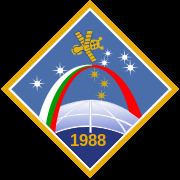COSPAR ID 1988-048A Period 1.5 hours Dates 7 Jun 1988 – 7 Sep 1988 Landing date 7 September 1988 | Orbits completed ~1,475 Manufacturer NPO Energia Apogee 241,000 m Launch date 7 June 1988 | |
 | ||
Mission duration 91 days, 10 hours, 46 minutes, 25 seconds Launch mass 7,000 kilograms (15,000 lb) | ||
Soyuz TM-5 was the fifth cosmonaut-carrying spacecraft to visit the Russian Space Station Mir. It was launched on June 7, 1988, carrying the Mir EP-2 mission's three-person crew. This week-long stay on Mir occurred during the third long-duration Mir expedition, Mir EO-3. The crew of EP-2 returned to Earth aboard Soyuz TM-4, while the TM-5 spacecraft remained docked to Mir, acting as the lifeboat for the long-duration crew. On September 7, 1988, the TM-5 spacecraft undocked from Mir, and landed Mir EP-3 mission's two-person visiting crew. The de-orbit procedures for Soyuz were revised after this flight, as multiple issues almost prevented the descent module's safe de-orbit and landing.
Contents
Launch
Soyuz TM-5 launched on 1988 June 7 and arrived at Mir on June 9 carrying the second Bulgarian in space, Alexandrov (not to be confused with the Soviet cosmonaut of the same name). He became the first Bulgarian to reach a Soviet space station (Georgi Ivanov failed to reach Salyut 6 on Soyuz 33 in 1979—Alexandrov was his backup). Their launch had been advanced by 2 weeks late in the planning stages to improve lighting conditions for the Rozhen astronomical experiment.
Landing
On September 5 cosmonauts Lyakhov and Mohmand undocked from Mir. They jettisoned the orbital module and made ready for deorbit burn to return to Earth. During descent, the spacecraft experienced a computer software problem combined with a sensor problem. This caused their landing to be delayed by a full day. The Descent Module, where they spent this 24-hour period, had no sanitary facilities. They would not have been able to redock with Mir because they had discarded the docking system along with the orbital module. Reentry occurred as normal on September 7. Following this incident, the Soviets decided that on future missions, they would retain the orbital module until after deorbit burn, as they had done on the Soyuz Ferry flights.
